Verdict
Whether it’s for TikTok, YouTube or even a DIY podcast, the Hollyland Lark C1 makes it incredibly easy to capture clear audio through your smartphone, which in turn makes it an essential buy for almost any content creator operating within a limited budget.
Pros
- Easy to use
- Fantastic audio quality
- Strong wireless connection
- Dispels background noise really well
Cons
- ANC mode noticeably affects audio quality
- Some distortion found in louder environments
-
Two microphones included:Record a conversation wirelessly and instantly -
Long-range wireless connection:Record audio up to 650ft away -
Active noise cancelling:Dispel ambient noise with one touch
Introduction
Trying to achieve clear audio is always a key component when filming with your phone, and the Hollyland Lark C1 is here to kick things up a notch.
As the skill set of smartphones in the realm of content creation has only continued to move to new heights, an abundance of accessories have hit the market to capitalise on their video and photographic capabilities.
Recently I reviewed the ShiftCam SnapGrip which turns the iPhone into something more akin to a traditional point-and-shoot camera, and now Chinese company Hollyland has sought to throw another accessory into the mix.
The Hollyland Lark C1 is a wireless mic set that’s been designed to work exclusively with smartphones. Given that phones themselves aren’t the best when it comes to recording quality audio, there’s a definite gap in the market for something like the Lark C1 to provide a more professional touch to smartphone filming. Having put the device to the test, we now know exactly how well it manages to achieve those aims.
Design
- Lightweight charging case
- Models available for iPhone and Android
- You can charge your phone through the receiver
From a distance, you’d be forgiven for thinking that the Hollyland Lark C1 was in fact a pair of earbuds, owing to its similar-in-style charging case, but look a little closer and you’ll realise that the case is a bit larger than that of your average earbuds. Open the case up and you’ll see the RX receiver and two wireless lapel mics, all nestled neatly inside.
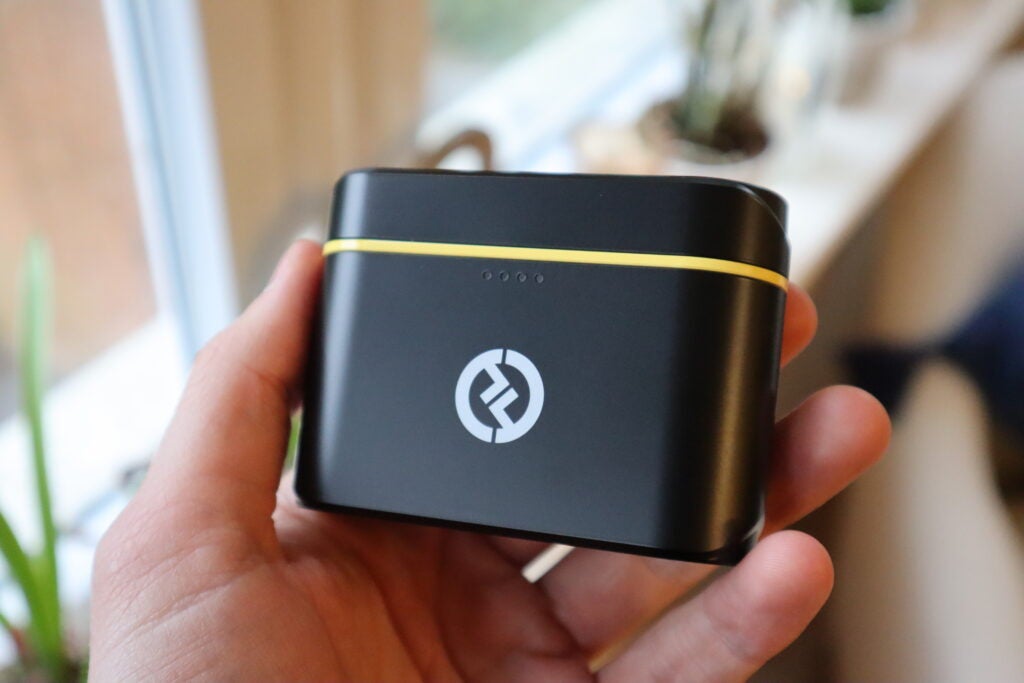
There are LED lights on the front of the case to let you know how much battery is left in the tank, and individual lights inside let you know if either mic is currently charging or ready to go with a full battery. The lid feels slightly flimsy when open but there’s a magnetic pull that keeps the case firmly shut, and there’s a satisfying click when closing it.
What’s most remarkable about the Lark C1 is just how lightweight everything is when it’s bundled into the charging case. You could easily pop it into a coat pocket and forget that it’s even there. This means that the Lark C1 doesn’t detract from the portability that makes smartphone filming so appealing in the first place.
That same lightweight feeling continues when you take the individual components out of the case, but never at the expense of feeling like it’s not up to the task. On the contrary, the RX receiver fits snugly into the iPhone’s Lightning port without any sense that it’ll fall out accidentally, and the clip on the lapel mic is the same length as its body which gives it ample room to get a serious grip on your clothing. As a side note, there is a USB-C version of the Lark C1 for use with Android phones.
There are just two buttons on the mics themselves, one for switching the mic on/off and the other to activate the active noise cancelling (ANC) mode. I would have liked to see a record button included so that I wouldn’t have to run back to my phone every time I wanted to start/stop the process, but it’s definitely not a dealbreaker.
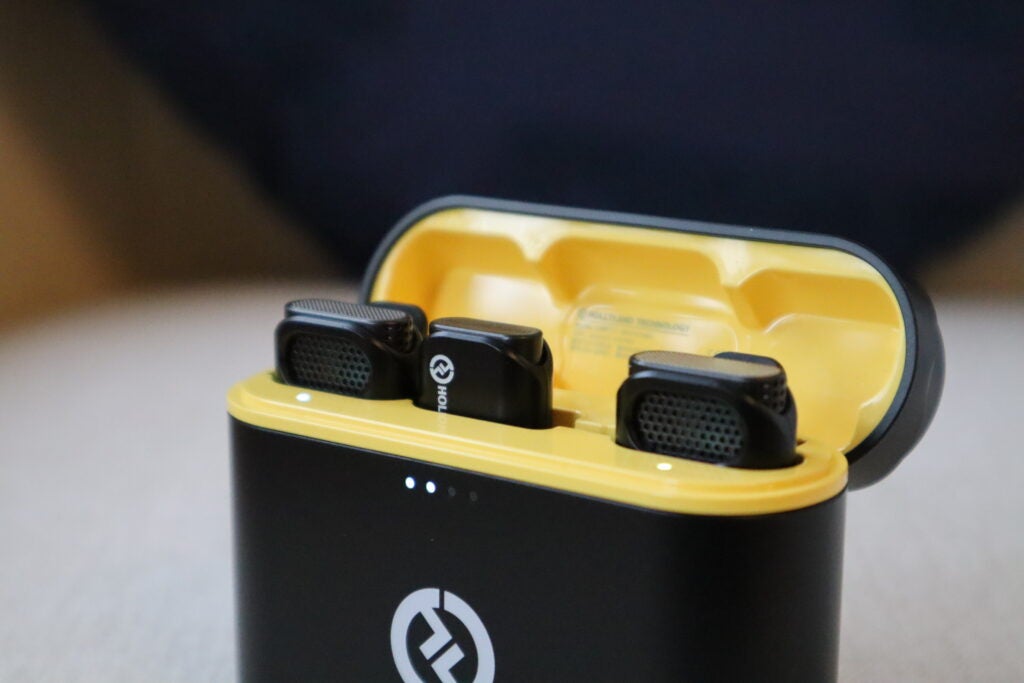
Features
- Hollyland app offers some customisation
- ANC is helpful but could use some work
- ‘Speaker Play’ fixes a big issue with phone accessories
One of the big headline features of the Lark C1 is its inclusion of ANC. While the feature has become a mainstay in the world of headphones, it’s still something of a novelty where microphones are concerned. Taking the Lark C1 to the Trusted Reviews rooftop, I was impressed to see that the ANC does a solid job of actually beating back any unwanted sounds that might otherwise interfere with the recording.
The downside is that in activating the mode, vocal quality takes a noticeable dip, not to the point where it’s unusable but pronounced enough that you won’t want to have the mode switched on constantly. At the very least, I feel confident knowing that if I needed to film in a busy or built-up area, then the ANC could be used in a pinch to prevent the vocals from being completely derided.
There is an accompanying app with the Lark C1 that offers an easy to read dashboard of your levels, making up for the absence of any screen on the device itself to show you that information (unlike the DJI Mic 2). You also have the ability to change the severity of the ANC as well as the volume of the recording itself, so you have some flexibility available to suit different scenes.
The app also lets you circumvent an issue that I’ve had with previous lapel mics where they intercept the audio from your phone during playback, effectively forcing you to remove the mic from the Lightning port in order to hear how your recording turned out. With the Lark C1, just toggle the ‘Speaker Play’ option in the app and you can hear your playback through the phone’s speakers without needing to take out the wireless receiver. If you need to charge your phone whilst using the Lark C1, there’s a charging port on the side of the receiver to keep things ticking without interruption.
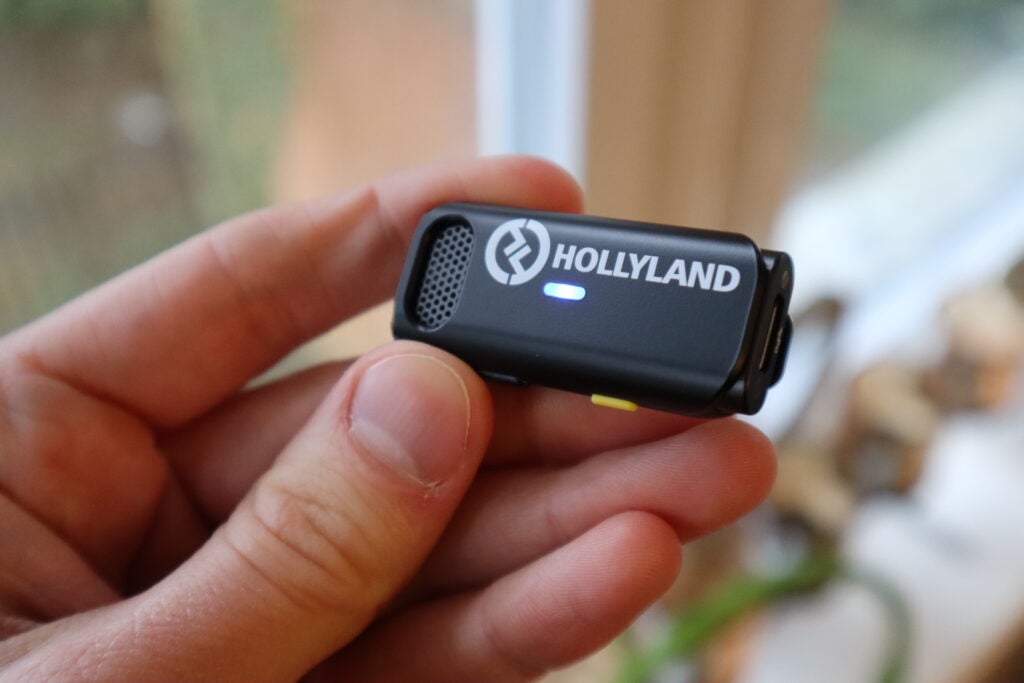
Hollyland claims that the Lark C1 has a full connection range of 650ft, which gives you the freedom to roam around in the shot without worrying that your dialogue won’t be heard. Of course, any testing in this regard is tricky without precise measuring tools but I was able to run all the way down to the end of the street without it affecting the quality of the audio recording. You’d be hard pressed to go beyond the reach in any given shot but for comparison’s sake, it is worth noting that the DJI Mic 2 has a range of 820ft which is worth bearing in mind if this is one of the key features you’re interested in.
When it comes to battery life, the Lark C1 has an estimated life cycle of up to 32 hours off the back of the charging case, with each microphone lasting for roughly eight hours before needing to be topped up. In the entirety of my testing, I never found myself needing to rush towards the nearest power outlet, and after 30 minutes of continuous recording, one of the mics was still registering 100% battery left in the tank so you’ll be absolutely fine with a full day of shooting.
Audio quality
- Excellent audio fidelity for the price
- Background noise is kept at bay
- Loud areas can cause some distortion in vocal recording
Given that the Lark C1 is far more budget-friendly than the DJI Mic 2, I anticipated that that might come at the cost of audio quality but after tons of testing, I found that the Hollyland Lark C1 actually holds its own with a level of audio that’s sure to please most buyers.
I’ve been using the Lark C1 to record the audio for my own TikTok and YouTube videos, and in these moments where I haven’t had to deal with any external noise or distractions, the Lark C1 mics have picked up my voice clearly without any hiccups in capture. They’ve been able to lend a serious bump in quality to the audio of my videos, to the point where I don’t ever see myself going back to using a wired lapel mic or (God forbid) the iPhone’s built-in microphone.
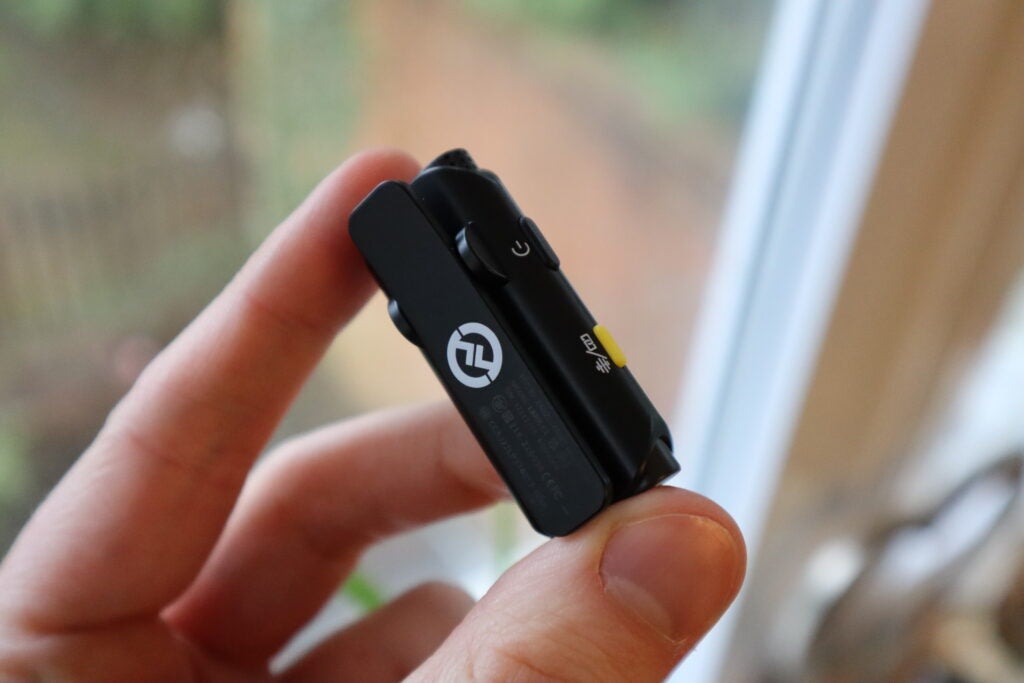
To see how the Lark C1 fared away from the comfort of my flat, I headed to two locations: the windy rooftop of the Trusted Reviews office, and the bustling show floor of MWC 2023. At the former, the Lark C1 allowed some of the rushing wind to get picked up (but not enough to deride the vocals) but more impressively, it managed to almost completely block out the consistent clanging from a nearby construction site.
When using both of the included mics to record a conversation, I came across no discernible echoing in the recording or any issues with overlapping dialogue, so if you want a low-cost set-up for recording a podcast then you can get by with what’s on offer here.
At MWC, I had absolutely no need to switch on the ANC mode as the mic managed to hone in on my voice perfectly whilst keeping the ambient chatter at bay. The only issue I found here is that when I spoke at a higher volume to be heard over the crowd, the Lark C1 struggled to maintain the same level of audio fidelity that could be heard in other scenarios, but it’s the type of distortion that an audiophile might pick up on while the average consumer probably won’t have any issues with it at all.
Either way, I found myself able to rely on the Lark C1 to record my voice during all of these scenarios, which is exactly the peace of mind that you’d want to have from this type of mic.
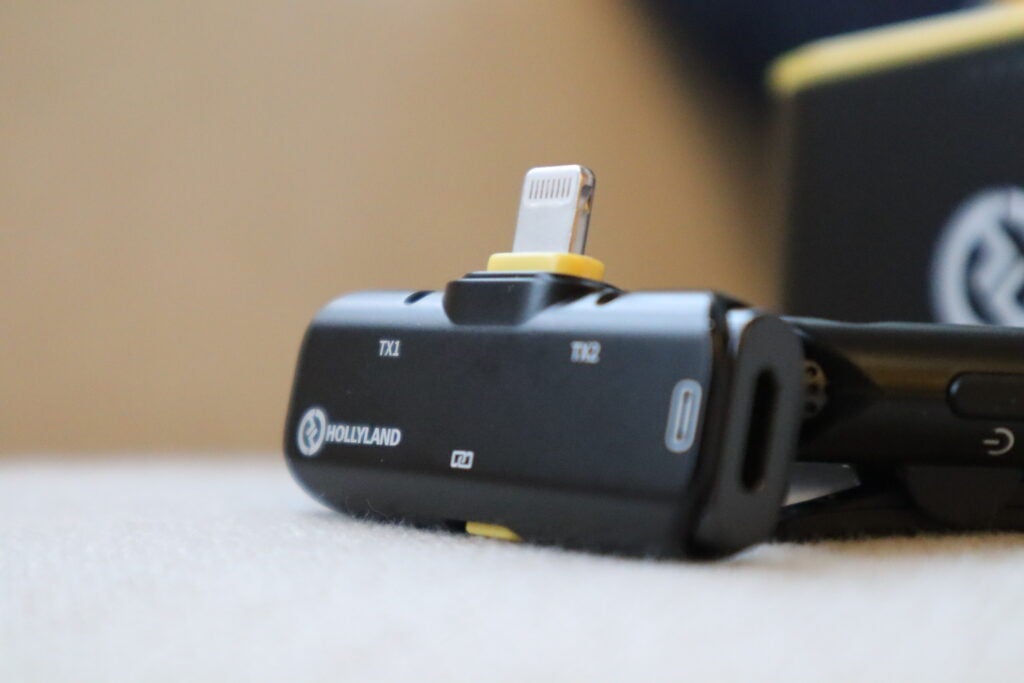
Should you buy it?
You want to shoot better audio with your phone: If you’re a content creator on a budget then I’d be hard pressed not to recommend the Hollyland Lark C1. For all that it offers, its ease of use and the asking price that comes with it, it’s an easy winner.
You want a professional level mic: As great as the Lark C1 is for most people, audiophiles may want to invest in pricier kit to get the best audio quality possible, and more customisation options to boot.
Final Thoughts
For any content creators out there who capture video and audio primarily with their smartphone, the Hollyland Lark C1 is a must-have accessory. In spite of its comparatively affordable price, the included microphones more than hold their own in demanding circumstances, and the 650ft range allows you to get creative with the type of shots you want to film.
The ANC, while efficient, could do with a bit of work for it to be something that I would happily rely on more often than not, and the overall audio quality can be bested by pricier options, but when shopping at this end of the market the Hollyland Lark C1 offers plenty of bang for your buck.
FAQs
There are two versions of the Hollyland Lark C1, one with a Lightning adapter that works with iPhone, and another that uses a USB-C connector to operate with Android phones.
Yes, there is an input port on the receiver that allows power to run through it, charging your phone as you record.
Sustainability
TrustedReviews’ holds the fact that global warming is not a myth as a core value and will continuously endeavor to help protect our planet from harm in its business practices.
As part of this mission, whenever we review a product we send the company a series of questions to help us gauge and make transparent the impact the device has on the environment.
We currently haven’t received answers to the questions on this product, but will update this page the moment we do. You can see a detailed breakdown of the questions we ask and why in our sustainability info page.
Jargon buster
ANC
ANC (Active Noise Cancellation) uses an array of microphones in a headphone to detect the frequency of the sound coming at the listener, with the ANC chip creating an inverse wave (i.e. opposing sound) to suppress any unwanted external noises.
















